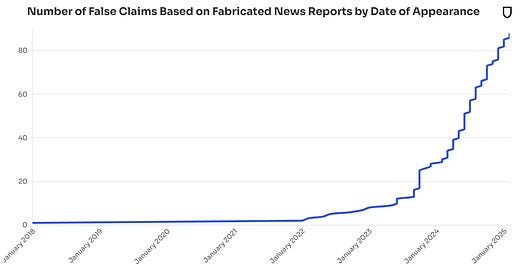Bad Actors Fake Being Real News Outlets at Alarming Rate
PLUS: Starlink Operating in Ukraine, Contrary to Deepfake Claims; Zelensky Outfit at Oval Office Meeting Spurs Temu, Hugo Boss Fakes
Welcome to Reality Check, your inside look at how misinformation online is undermining trust — and who’s behind it.
Our work is more important than ever. Please support us by becoming a Premium Member. And forward this email to a friend to spread the word!
Follow us on your social media platform of choice: X | LinkedIn | Instagram | Bluesky
Today:
Disinformers impersonate reputable media outlets to advance sophisticated false narratives
False claims about Starlink in Ukraine trend in pro-Kremlin media
Fashion fail: Focus on Zelensky outfit at White House meeting inspires falsehoods
And More …
Today’s newsletter was edited by Eric Effron and Sofia Rubinson.
1. Bad Actors Increasingly Pretend to be Real News Outlets to Advance False Claims
A video styled as a Wall Street Journal report advances the false claim that Vice President J.D. Vance refused to speak with a top Ukrainian official. A video designed to look like E! News falsely claims that the outlet reported that USAID funded celebrity trips to Ukraine. A fake Economist cover warns of an “Apocalypse” and World War III after the U.S. approved long-range missiles for Ukraine.
The list of malign actors — primarily Russian government agents — hijacking real media brands to push false claims is accelerating. A NewsGuard analysis found that since 2018, bad actors have pushed 88 false claims based on fabricated news reports impersonating 40 reliable media organizations. And the tactic had become more widespread with each passing year. (See chart above.)
A closer look: Disinformation actors are deliberately mimicking the names, logos, and formatting of trusted news organizations, including by using AI, to make their false claims appear legitimate.
By replicating the visual identity and tone of traditional blue-chip outlets, they exploit the credibility of these organizations and aim to increase the chances that the false narrative will spread widely and be believed despite being baseless.
Of the 88 instances of this tactic identified by NewsGuard:
Sixty-three (71.6%) originated from Russian influence operations, including Matryoshka, which spreads anti-Ukraine disinformation using fake reports styled after outlets such as the BBC. One bogus BBC report falsely claimed that journalism group Reporters Without Borders identified over 1,000 instances of Nazi symbols being used by the Ukrainian military during its incursion into Russia’s Kursk region.
Seventeen (19.3%) originated from U.S.- and U.K.-based players, often social media users from the right and the left who have digitally manipulated news broadcast graphics or falsely cited a reputable outlet to add credibility to a bogus claim. For example, in May 2023, users on the left and the right shared a photo purporting to show an X post from Bloomberg announcing an explosion near the Pentagon.
Eight (9.1%) were created by Iranian state actors using tactics similar to the Russian campaigns. For example, in early February 2025, Iranian state media outlets shared an image of a supposed Wall Street Journal article by reporter Jack Gillum headlined, “Trump's Condition for Talks with Iran: Return of the Three Islands to the UAE.” (Gillum told NewsGuard in an emailed statement, “I didn’t write that story.”)
Same playbook: The spread of the fake news reports typically follows the same pattern:
Disinformation campaigns upload such fakes en masse daily, hoping that even if most are ignored or debunked, some will gain traction. (As NewsGuard and other organizations have previously reported, many fakes are aimed at overloading Western fact checkers with false claims that are time-consuming to verify and have no or little engagement with news consumers. NewsGuard only reports on Matryoshka-related claims when they have organic viral spread among audiences, rather than responding to targeted spam.)
A high-profile figure such as Rep. Marjorie Taylor Greene or X owner Elon Musk views one of the fake news reports and shares it on social media.
Despite being widely debunked, the fake continues circulating and is eventually picked up by Russian media, where it is pushed into the global media sphere.
Upping their game: Initially relying on photoshopped images, disinformers are increasingly leveraging generative AI tools for enhanced fake news production.
In 2022, pro-Kremlin sources spread a supposed BBC graphic showing how Ukrainian politicians profited from the Russia-Ukraine war (below). The graphic is clearly fabricated, with uneven text of varying sizes imposed on the chart.
A 2024 fabricated BBC video claiming that three Ukrainian oligarchs donated $8 million to President Donald Trump’s campaign has a higher-quality production, appearing nearly identical to a legitimate BBC video through sophisticated use of AI.
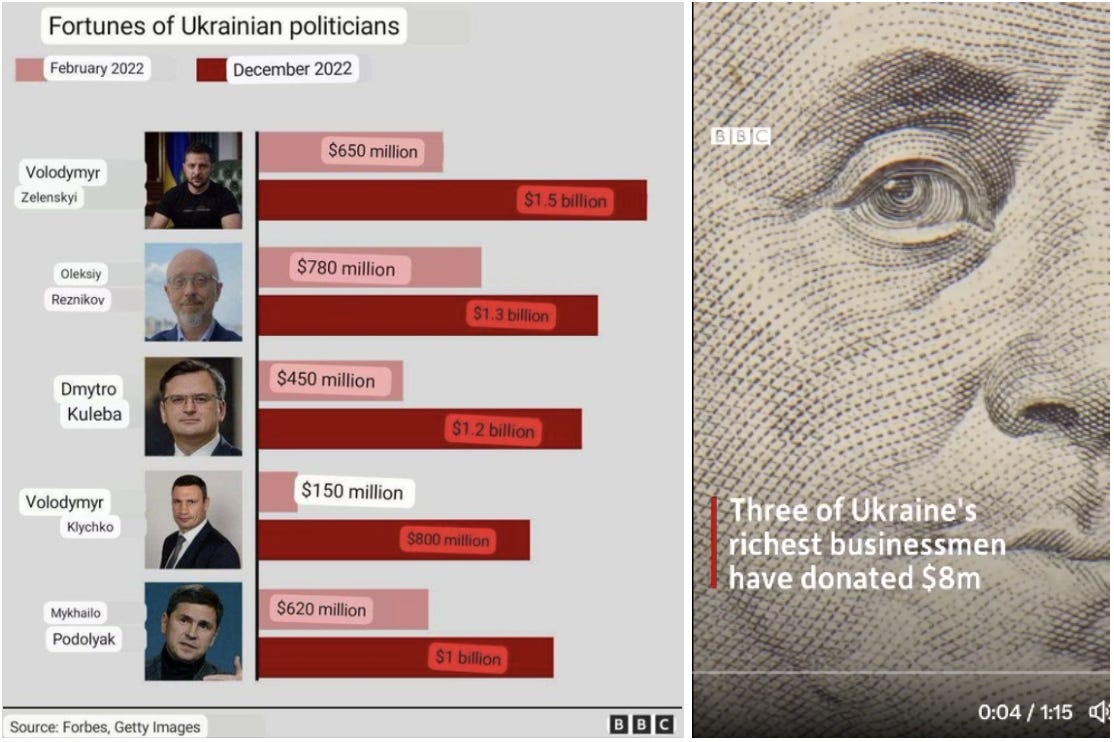
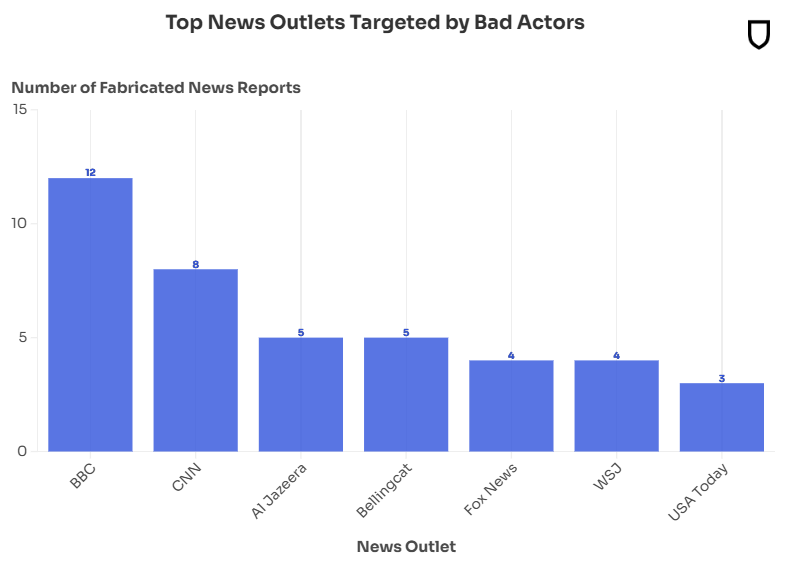
Frequent targets: NewsGuard found that the BBC, Bellingcat, CNN, and USA Today are among the most impersonated outlets.
CNN spokesperson Anna Jager told NewsGuard in a March 2025 email: “Any attempt to misuse trusted institutions to spread malice and misinformation is deeply concerning. CNN takes these instances very seriously and will continue to push back against bad actors using our brand to manipulate readers and spread false information for their own opportunistic purposes.”
Bellingcat has repeatedly addressed the fakes on X. Bellingcat founder Eliot Higgins wrote in a Jan. 16, 2024, X post, “It's quite the compliment that they consider their target audience holds Bellingcat in such high regard.”
A report from cybersecurity company Recorded Future about such fakes said, “Brand abuse in the context of influence operations can also lead to reputational damages, contribute to the erosion of consumer trust, and deter advertisers, thereby inflicting financial harm on the impersonated organizations.”
An Exclusive Briefing for Reality Check Members
Reality Check members are invited to an exclusive briefing by NewsGuard’s Co-CEOs and analysts on March 13th at 1pm ET. We’ll dissect three recent misinformation narratives — examining how they emerged and spread, who was behind them, and how our analysts tracked them down. Become a member today for an invitation to this exclusive event.
Members also get a FREE copy of the definitive book on the misinformation crisis, The Death of Truth by NewsGuard Co-CEO and bestselling author Steven Brill ($30 value), free access to NewsGuard's browser extension that shows reliability ratings for 11K+ news sites right in your browser ($25 value), and unlimited access to our members-only content and archives.
2. Speaking of Pretend News Reports: CNN and Marco Rubio Falsely Tied to Bogus Statements About Starlink and Ukraine
By Macrina Wang and Sofia Rubinson
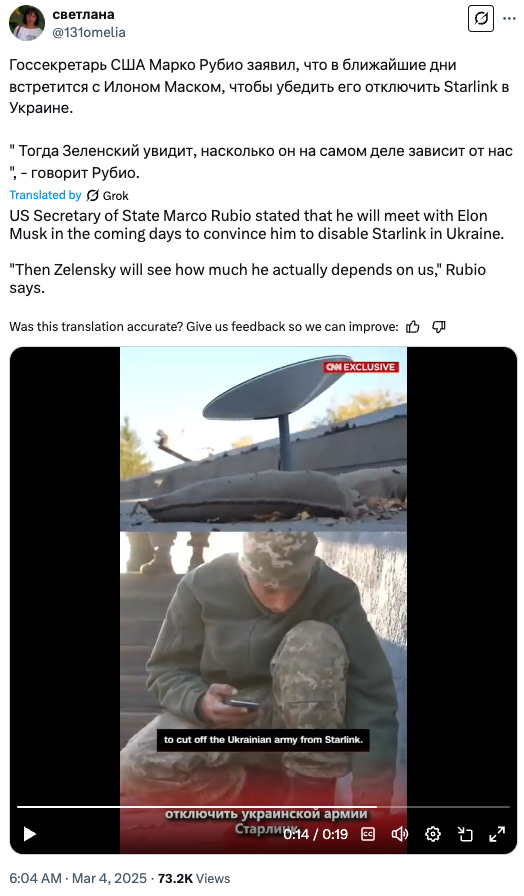
What happened: Following Ukrainian President Volodymyr Zelensky’s contentious visit at the White House on Feb. 28, pro-Kremlin sources spread two false claims related to the Ukrainian army and its access to Starlink — the satellite internet service owned by Trump senior advisor Elon Musk that has been crucial for the army during its war with Russia.
Rubio deepfake: Pro-Russian sources spread a doctored video of U.S. Secretary of State Marco Rubio supposedly saying in a CNN interview, “In the next few days, I will see Elon Musk and I swear I will convince him to cut off the Ukrainian army from Starlink.”
You can watch the video here:
A closer look: The video appears to have first been posted on Telegram on March 4, 2025, by Russian pro-Kremlin military blogger Boris Rozhin, who was sanctioned by Ukraine for spreading Russian propaganda about the war. It received 206,000 views in eight hours.
A March 4 article by pro-Kremlin website TopWar.ru (Trust Score: 20/100) said, “Commenting on Zelensky’s behavior in the White House during a recent interview with CNN, US Secretary of State Marco Rubio promised to discuss with Elon Musk in the coming days the shutdown of the Starlink satellite Internet in Ukraine.” The article added, “It is worth noting that the militants of the Kiev regime will be the first to ‘see’ this, since the shutdown of Starlink looks much more threatening for the Ukrainian Armed Forces than even the cessation of American weapons supplies.”
Actually: The portion of the video’s audio in which Rubio appears to discuss cutting off the Ukrainian army’s access to Starlink is AI-generated.
The altered video accurately shows a portion of an interview Rubio conducted with CNN reporter Kaitlan Collins discussing the Feb. 28 Oval Office incident. Rubio said that Zelensky should “apologize for turning this thing into the fiasco for him that it became.”
Rubio never mentioned Musk or Starlink at any point in the CNN interview, according to NewsGuard’s review of the broadcast and a transcript of the interview published on the State Department’s website.
CNN targeted again: Pro-Kremlin accounts also spread a screenshot of a purported CNN article titled “Starlink rolling blackouts” that stated, “Ukrainian military formations have been recording regular Starlink blackouts across the front line since Zelensky’s visit to the White House.”
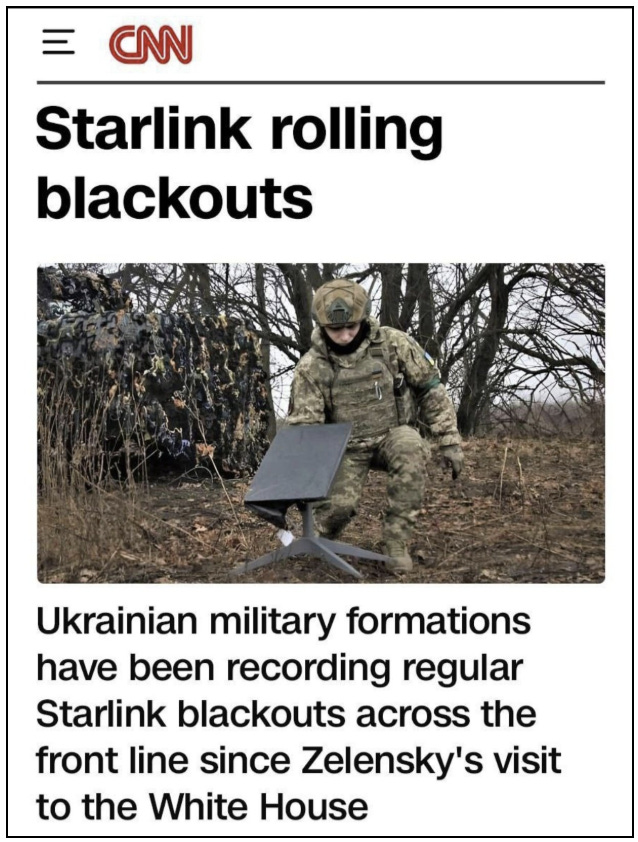
A closer look: Although it is unclear where the claim and fabricated screenshot originated, they spread on pro-Kremlin websites and Telegram channels.
TheOtherUkraine.info, a pro-Russian news site, published the screenshot on March 5 and stated, “Starlink satellite internet, provided by Elon Musk’s SpaceX, is being shut down across the front lines in Ukraine, CNN reports.”
Actually: The CNN article is fake, and there are no credible reports of Starlink blackouts in Ukraine.
A NewsGuard keyword search of CNN.com turned up no articles with this title or text or any article about Starlink blackouts in Ukraine.
The screenshot shows signs of manipulation. It displays the CNN logo above the headline without the website’s usual “Politics” label typically used in articles about Ukraine. The site’s standard menu options are also missing, leaving an empty white space where they would normally appear.
Context: In late February 2025, news agency Reuters (Trust Score: 100/100) reported that in negotiations with Ukrainian officials, U.S. officials seeking access to Ukrainian mineral reserves to compensate for U.S. military support raised the possibility of blocking the country’s access to Starlink.
The report was refuted by Musk, who stated in a Feb. 22 X post: “This is false. Reuters is lying.”
NewsGuard sent an email to CNN and a contact form inquiry to the U.S. State Department seeking comment but did not receive a response.
Click here to find out more about NewsGuard Trust Scores and our process for rating websites. You can download NewsGuard’s browser extension, which displays NewsGuard Trust Score icons next to links on search engines, social media feeds, and other platforms by clicking here.
3. Suit Yourself: Zelensky Target of False Claims Over White House Outfit
By Sarah Komar and Nicole Dirks
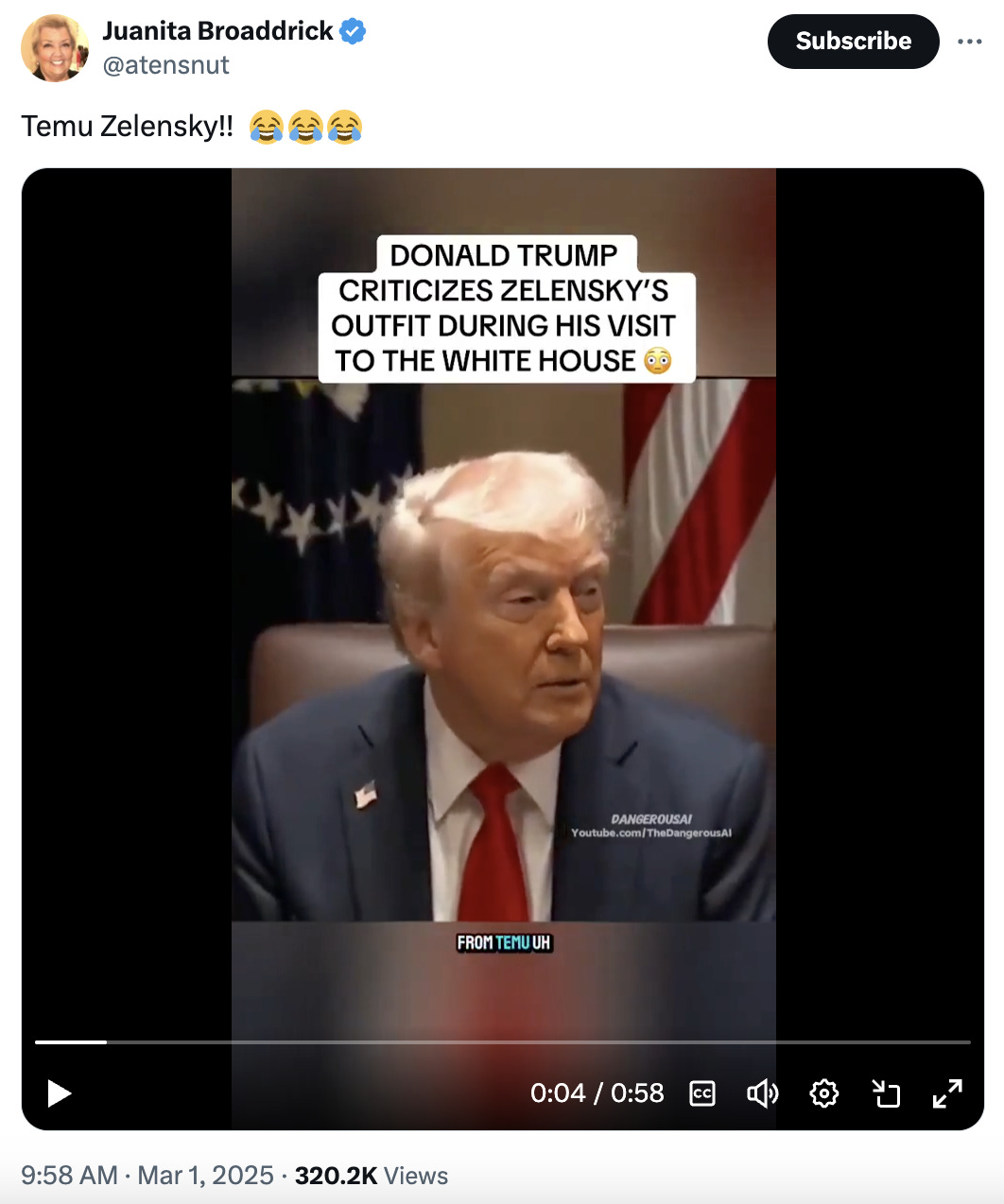
What happened: Ukrainian President Volodymyr Zelensky’s choice of White House attire has drawn two fashion brands into the controversy, with both having to fend off false claims.
The first claim holds that U.S. President Donald Trump said Zelensky disrespected the Oval Office by wearing an outfit from Temu, a Chinese-owned, ultra cheap online marketplace. The second states that designer fashion brand Hugo Boss offered Zelensky a suit after the contentious meeting.
Context: At the Oval Office meeting, Zelensky wore a black sweater emblazoned with the Ukrainian coat of arms, slim-cut black slacks, and black boots. (He has not worn a suit in public since Russia’s invasion of Ukraine in 2022, instead dressing more casually in solidarity with frontline Ukrainian soldiers, according to British outlet The Times (Trust Score: 100/100).
When Trump greeted Zelensky, he sarcastically remarked, “You’re all dressed up today.” Conservative commentator Brian Glenn asked Zelensky during the meeting, “You’re in the highest level of this country’s office, and you refuse to wear a suit?”
A closer look: In a fabricated video, Trump appears to say, “President Zelensky showed up to the White House wearing an outfit from Temu, and I found that very disrespectful, I have to be honest. I’m going to start calling him ‘Temu Zelensky.’ … Sleepy Joe gave this guy $500 billion and he can’t even afford a $1,000 suit? What a cheap guy. He spent all that money that U.S. taxpayers gave him and spent it on the Temu app.”
You can watch the video here:
On March 1, 2025, Juanita Broaddrick, a former nurse who accused former President Bill Clinton of rape, shared the video on X and said, “Temu Zelensky!!” The post received 320,000 views and 12,000 likes in five days.
Pro-Kremlin Telegram user @kozakrichala shared the video on March 1 accompanied by a transcription of the video’s voiceover, translated in Russian. The post received 116,300 views in five days.
Actually: The video was first published on March 1 on a YouTube channel called “DangerousAI,” which posts original “AI parody content,” according to its bio. The bio also states: “I create my content by writing original scripts and I use AI for the voiceover. Edited by me to add that extra flair and ensure you get the best entertainment possible.”
As first reported by Ukrainian fact-checking organization StopFake.org, the original footage the creator used was filmed during a Feb. 26 Trump Cabinet meeting. Close-up shots of Trump from the meeting match the scene shown in the manipulated video, but the meeting took place two days before Zelensky’s White House visit.
Designer offer: Pro-Kremlin sources also spread a purported screenshot of an Instagram post from high-end brand Hugo Boss featuring a photo of Zelensky on the day of the meeting with text that said, “Dear Mr. Zelensky, we are ready to offer you a suit for your business negotiations.”
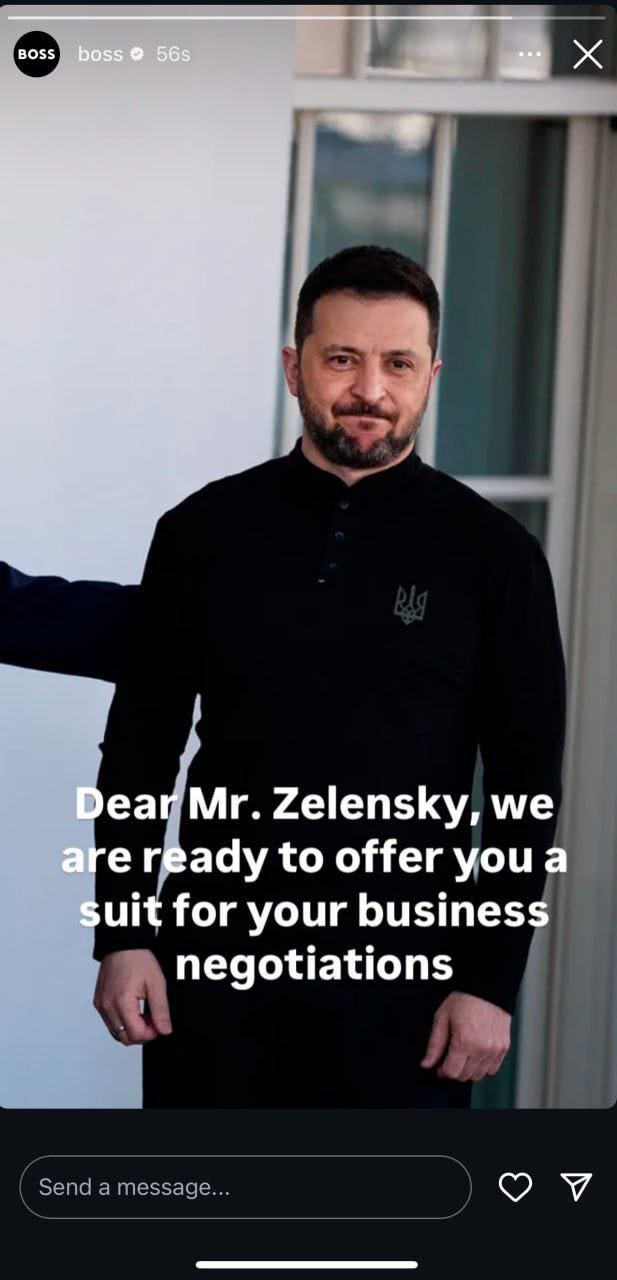
Some users joked that Hugo Boss could give Zelensky a Nazi uniform — a reference to the fact that the company once produced uniforms for Germany’s Nazi regime. (Company founder Hugo Boss, a German, joined the Nazi party in the early 1930s, The Associated Press reported in 1997.)
Pro-Kremlin Telegram user “Cat Kostyan” posted the screenshot and said: “Hugo Boss is ready to provide the green nit-picker with a suit for business negotiations. Logically, who else should dress up as Nazis!” The post received 89,200 views in three days.
Pro-Kremlin Russian X user @Q9rNY6DsAnLBJGy posted the screenshot alongside an image showing a 1934 Hugo Boss collection of Nazi uniforms and added: “Hugo boss writes on his social networks that the company is ready to provide a suit to Zelensky for business negotiations. And it seems that it will be a suit from old collections…” The post garnered 82 views in two days.
Actually: The screenshot originated on a parody X account.
The first appearance of the image NewsGuard found was in a March 4 X post by Russian user @serebrotank76, which describes itself as a “Parody account.”
A NewsGuard review of Hugo Boss’ official Instagram accounts found no such post.
Hugo Boss spokesperson Laura Landschof told NewsGuard in a March 2025 email: “The image you are referring to was never posted on the official BOSS Instagram account — neither as a story nor as a post. This is nothing that has been shared by the company HUGO BOSS or the BOSS brand.”
If you see something, say something
If you see or hear something that you think may be provably false, please alert NewsGuard via realitycheck@newsguardtech.com and we'll do our best to get to the bottom of it. Note: Tips should not include content that you simply disagree with, however strongly.
Reality Check is produced by Co-CEOs Steven Brill and Gordon Crovitz, and the NewsGuard team.
We launched Reality Check after seeing how much interest there is in our work beyond the business and tech communities that we serve. Subscribe to this newsletter to support our apolitical mission to counter misinformation for readers, brands, and democracies. Our work is more important than ever. Have feedback? Send us an email: realitycheck@newsguardtech.com.

